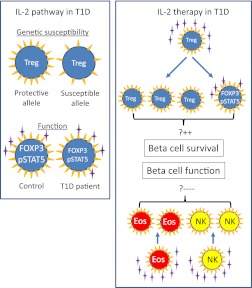FIG. 1.
Il-2 pathway in the pathogenesis of type 1 diabetes (T1D) (left box) and observed effects of IL-2/rapamycin therapy in patients with type 1 diabetes (right box). Susceptibility to type 1 diabetes is conferred by numerous genes including the IL-2 receptor α (CD25) gene. Tregs in subjects with type 1 diabetes–susceptible alleles express less CD25 (yellow triangles) than those from subjects with protective alleles (7). Moreover, Tregs from patients with type 1 diabetes are less responsive to IL-2 (purple stars) with lower FOXP3 expression and less STAT5 signaling than Tregs from control subjects (9). During IL-2/rapamycin treatment (2), IL-2 increased the number of circulating Tregs and led to a rescue of their IL-2 responsiveness in patients. This is presumed to prevent loss of β-cells and increase β-cell survival and function (upper part of the right box). However, treatment also expanded other CD25 bearing cells of innate immunity such as eosinophils (Eos) and natural killer (NK) cells and this is presumed to be responsible for the marked impairment in β-cell function observed in the study (lower part of the right box).

